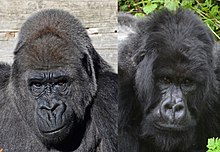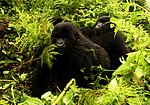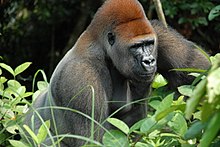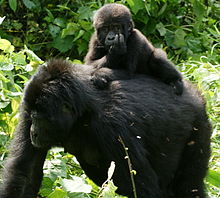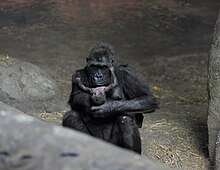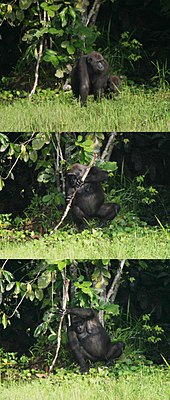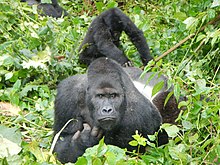| Gorillas | |
|---|---|

| |
| Western gorilla (Gorilla gorilla) | |
| Scientific classification | |
| Kingdom: | Animalia |
| Phylum: | Chordata |
| Class: | Mammalia |
| Order: | Primates |
| Suborder: | Haplorhini |
| Infraorder: | Simiiformes |
| Family: | Hominidae |
| Subfamily: | Homininae |
| Tribe: | Gorillini |
| Genus: | Gorilla I. Geoffroy Saint-Hilaire, 1852 |
| Type species | |
| Troglodytes gorilla
Savage, 1847
| |
| Species | |
|
Gorilla gorilla
Gorilla beringei
| |
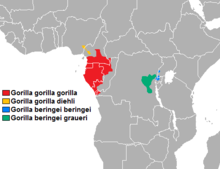
| |
| Distribution of gorillas | |
| Synonyms | |
| |
Gorillas are ground-dwelling, predominantly herbivorous apes that inhabit the forests of central Sub-Saharan Africa. The genus Gorilla is divided into two species: the eastern gorillas and the western gorillas (both critically endangered), and either four or five subspecies. They are the largest living primates. The DNA of gorillas is highly similar to that of humans, from 95 to 99% depending on what is included, and they are the next closest living relatives to humans after the chimpanzees and bonobos.
Gorillas' natural habitats cover tropical or subtropical forests in Sub-Saharan Africa. Although their range covers a small percentage of Sub-Saharan Africa, gorillas cover a wide range of elevations. The mountain gorilla inhabits the Albertine Rift montane cloud forests of the Virunga Volcanoes, ranging in altitude from 2,200 to 4,300 metres (7,200 to 14,100 ft). Lowland gorillas live in dense forests and lowland swamps and marshes as low as sea level, with western lowland gorillas living in Central West African countries and eastern lowland gorillas living in the Democratic Republic of the Congo near its border with Rwanda.
Etymology
The word "gorilla" comes from the history of Hanno the Navigator, (c. 500 BC) a Carthaginian explorer on an expedition on the west African coast to the area that later became Sierra Leone. Members of the expedition encountered "savage people, the greater part of whom were women, whose bodies were hairy, and whom our interpreters called Gorillae". The word was then later used as the species name, though it is unknown whether what these ancient Carthaginians encountered were truly gorillas, another species of ape or monkeys, or humans.The American physician and missionary Thomas Staughton Savage and naturalist Jeffries Wyman first described the western gorilla (they called it Troglodytes gorilla) in 1847 from specimens obtained in Liberia. The name was derived from Ancient Greek Γόριλλαι (gorillai), meaning 'tribe of hairy women', described by Hanno.
Evolution and classification
The closest relatives of gorillas are the other two Homininae genera, chimpanzees and humans, all of them having diverged from a common ancestor about 7 million years ago. Human gene sequences differ only 1.6% on average from the sequences of corresponding gorilla genes, but there is further difference in how many copies each gene has. Until recently, gorillas were considered to be a single species, with three subspecies: the western lowland gorilla, the eastern lowland gorilla and the mountain gorilla. There is now agreement that there are two species, each with two subspecies. More recently, a third subspecies has been claimed to exist in one of the species. The separate species and subspecies developed from a single type of gorilla during the Ice Age, when their forest habitats shrank and became isolated from each other.Some variations that distinguish the classifications of gorilla include varying density, size, hair colour, length, culture, and facial widths. Population genetics of the lowland gorillas suggest that the western and eastern lowland populations diverged ~261 thousand years ago.
Physical characteristics
Male gorilla skull
Gorillas move around by knuckle-walking, although they sometimes walk bipedally for short distances while carrying food or in defensive situations,
and some Mountain Gorillas use other parts of their hand to aid
locomotion (studies of 77 Mountain Gorillas published in 2018 showed 61%
only used knuckle walking, but the remainder used knuckle walking plus
other parts of their hand—fist walking in ways that do not use the
knuckles, using the backs of their hand, and using their palms).
Wild male gorillas weigh 136 to 195 kg (300 to 430 lb), while adult
females usually weigh about half as much as adult males at 68–113 kg
(150–250 lb).
Western gorilla (Gorilla gorilla) and Eastern gorilla (Gorilla beringei)
Adult males are 1.4 to 1.8 m (4 ft 7 in to 5 ft 11 in) tall, with an
arm span that stretches from 2.3 to 2.6 m (7 ft 7 in to 8 ft 6 in).
Female gorillas are shorter at 1.25 to 1.5 m (4 ft 1 in to 4 ft 11 in),
with smaller arm spans.
Groves (1970) calculates that average weight of the 47 wild adult male
gorillas is 143 kg, while Smith and Jungers(1997) found that the average
weight of the 19 wild adult male gorillas is 169 kg.
Adult male gorillas are known as silverbacks due to the characteristic
silver hair on their backs reaching to the hips. The tallest gorilla
recorded was a 1.95 m (6 ft 5 in) silverback with an arm span of 2.7 m
(8 ft 10 in), a chest of 1.98 m (6 ft 6 in), and a weight of 219 kg
(483 lb), shot in Alimbongo, northern Kivu in May 1938. The heaviest gorilla recorded was a 1.83 m (6 ft 0 in) silverback shot in Ambam, Cameroon, which weighed 267 kg (589 lb). Males in captivity are noted to be capable of reaching weights up to 310 kg (683 lb). Gorilla facial structure is described as mandibular prognathism, that is, the mandible protrudes farther out than the maxilla. Adult males also have a prominent sagittal crest.
The eastern gorilla is more darkly coloured than the western
gorilla, with the mountain gorilla being the darkest of all. The
mountain gorilla also has the thickest hair. The western lowland gorilla
can be brown or grayish with a reddish forehead. In addition, gorillas
that live in lowland forests are more slender and agile than the more
bulky mountain gorillas. The eastern gorilla also has a longer face and
broader chest than the western gorilla.
Studies have shown gorilla blood is not reactive to anti-A and anti-B monoclonal antibodies, which would, in humans, indicate type O blood. Due to novel sequences, though, it is different enough to not conform with the human ABO blood group system, into which the other great apes fit. Like humans, gorillas have individual fingerprints.
Their eye colour is dark brown, framed by a black ring around the iris.
Distribution and habitat
Young gorilla climbing
Gorillas have a patchy distribution. The range of the two species is separated by the Congo River and its tributaries.
The western gorilla lives in west central Africa, while the eastern
gorilla lives in east central Africa. Between the species, and even
within the species, gorillas live in a variety of habitats and
elevations. Gorilla habitat ranges from montane forests
to swamps. Eastern gorillas inhabit montane and submontane forests
between 650 and 4,000 m (2,130 and 13,120 ft) above sea level.
Mountain gorillas live in the montane forests at the higher ends of the
elevation range, while eastern lowland gorillas live in submontane
forests at the lower ends of the elevation range. In addition, eastern
lowland gorillas live in montane bamboo forests, as well as lowland
forests ranging from 600–3,308 m (1,969–10,853 ft) in elevation.
Western gorillas live in both lowland swamp forests and montane
forests, and elevations ranging from sea level to 1,600 m (5,200 ft).
Western lowland gorillas live in swamp and lowland forests ranging up
to 1,600 m (5,200 ft), and Cross River gorillas live in low-lying and
submontane forests ranging from 150–1,600 m (490–5,250 ft).
Nesting
Gorilla night nest constructed in a tree
Gorillas construct nests for daytime and night use. Nests tend to be
simple aggregations of branches and leaves about 2 to 5 ft (0.61 to
1.52 m) in diameter and are constructed by individuals. Gorillas, unlike
chimpanzees or orangutans, tend to sleep in nests on the ground. The
young nest with their mothers, but construct nests after three years of
age, initially close to those of their mothers. Gorilla nests are distributed arbitrarily and use of tree species for site and construction appears to be opportunistic. Nest-building by great apes is now considered to be not just animal architecture, but as an important instance of tool use.
Food and foraging
A gorilla's day is divided between rest periods and travel or feeding
periods. Diets differ between and within species. Mountain gorillas
mostly eat foliage, such as leaves, stems, pith, and shoots, while fruit
makes up a very small part of their diets.
Mountain gorilla food is widely distributed and neither individuals nor
groups have to compete with one another. Their home ranges average
3–15 km2 (1.16–5.79 mi2), and their movements range around 500 m (0.31 mi) or less on an average day. Despite eating a few species in each habitat, mountain gorillas have flexible diets and can live in a variety of habitats.
Gorillas moving in habitat
Gorilla foraging
Eastern lowland gorillas have more diverse diets, which vary
seasonally. Leaves and pith are commonly eaten, but fruits can make up
as much as 25% of their diets. Since fruit is less available, lowland
gorillas must travel farther each day, and their home ranges vary from
2.7–6.5 km2 (1.04 to 2.51 mi2), with day ranges 154–2,280 m (0.096–1.417 mi). Eastern lowland gorillas will also eat insects, preferably ants. Western lowland gorillas depend on fruits more than the others and they are more dispersed across their range.
They travel even farther than the other gorilla subspecies, at 1,105 m
(0.687 mi) per day on average, and have larger home ranges of 7–14 km2 (2.70–5.41 mi2).
Western lowland gorillas have less access to terrestrial herbs,
although they can access aquatic herbs in some areas. Termites and ants
are also eaten.
Gorillas rarely drink water "because they consume succulent
vegetation that is comprised of almost half water as well as morning
dew", although both mountain and lowland gorillas have been observed drinking.
Behaviour
Social structure
Gorillas live in groups called troops. Troops tend to be made of one
adult male or silverback, multiple adult females and their offspring. However, multiple-male troops also exist.
A silverback is typically more than 12 years of age, and is named for
the distinctive patch of silver hair on his back, which comes with
maturity. Silverbacks also have large canine teeth that also come with
maturity. Both males and females tend to emigrate from their natal
groups. For mountain gorillas, females disperse from their natal troops
more than males. Mountain gorillas and western lowland gorillas also commonly transfer to second new groups.
Mature males also tend to leave their groups and establish their
own troops by attracting emigrating females. However, male mountain
gorillas sometimes stay in their natal troops and become subordinate to
the silverback. If the silverback dies, these males may be able to
become dominant or mate with the females. This behaviour has not been
observed in eastern lowland gorillas. In a single male group, when the
silverback dies, the females and their offspring disperse and find a new
troop. Without a silverback to protect them, the infants will likely fall victim to infanticide. Joining a new group is likely to be a tactic against this.
However, while gorilla troops usually disband after the silverback
dies, female eastern lowlands gorillas and their offspring have been
recorded staying together until a new silverback transfers into the
group. This likely serves as protection from leopards.
Silverback gorilla
The silverback is the center of the troop's attention, making all the
decisions, mediating conflicts, determining the movements of the group,
leading the others to feeding sites, and taking responsibility for the
safety and well-being of the troop. Younger males subordinate to the
silverback, known as blackbacks, may serve as backup protection.
Blackbacks are aged between 8 and 12 years
and lack the silver back hair. The bond that a silverback has with his
females forms the core of gorilla social life. Bonds between them are
maintained by grooming and staying close together.
Females form strong relationships with males to gain mating
opportunities and protection from predators and infanticidal outside
males.
However, aggressive behaviours between males and females do occur, but
rarely lead to serious injury. Relationships between females may vary.
Maternally related females in a troop tend to be friendly towards each
other and associate closely. Otherwise, females have few friendly
encounters and commonly act aggressively towards each other.
Females may fight for social access to males and a male may intervene.
Male gorillas have weak social bonds, particularly in multiple-male
groups with apparent dominance hierarchies and strong competition for
mates. Males in all-male groups, though, tend to have friendly
interactions and socialise through play, grooming, and staying together, and occasionally they even engage in homosexual interactions.
Severe aggression is rare in stable groups, but when two mountain
gorilla groups meet, the two silverbacks can sometimes engage in a fight
to the death, using their canines to cause deep, gaping injuries.
Competition
One possible predator of gorillas is the leopard. Gorilla remains have been found in leopard scat, but this may be the result of scavenging.
When the group is attacked by humans, leopards, or other gorillas, an
individual silverback will protect the group, even at the cost of his
own life.
Reproduction and parenting
Young gorilla riding on mother
Females mature at 10–12 years (earlier in captivity), and males at
11–13 years. A female’s first ovulatory cycle occurs when she is six
years of age, and is followed by a two-year period of adolescent
infertility.
The estrous cycle lasts 30–33 days, with outward ovulation signs subtle
compared to those of chimpanzees. The gestation period lasts 8.5
months. Female mountain gorillas first give birth at 10 years of age and
have four-year interbirth intervals. Males can be fertile before reaching adulthood. Gorillas mate year round.
Females will purse their lips and slowly approach a male while
making eye contact. This serves to urge the male to mount her. If the
male does not respond, then she will try to attract his attention by
reaching towards him or slapping the ground. In multiple-male groups, solicitation indicates female preference, but females can be forced to mate with multiple males. Males incite copulation by approaching a female and displaying at her or touching her and giving a "train grunt". Recently, gorillas have been observed engaging in face-to-face sex, a trait once considered unique to humans and bonobos.
Mother gorilla with 10-day-old infant
Gorilla infants are vulnerable and dependent, thus mothers, their primary caregivers, are important to their survival. Male gorillas are not active in caring for the young, but they do play a role in socialising them to other youngsters.
The silverback has a largely supportive relationship with the infants
in his troop and shields them from aggression within the group. Infants remain in contact with their mothers for the first five months and mothers stay near the silverback for protection. Infants suckle at least once per hour and sleep with their mothers in the same nest.
Infants begin to break contact with their mothers after five
months, but only for a brief period each time. By 12 months old, infants
move up to five meters (16 feet) from their mothers. At around 18–21
months, the distance between mother and offspring increases and they
regularly spend time away from each other. In addition, nursing decreases to once every two hours.
Infants spend only half of their time with their mothers by 30 months.
They enter their juvenile period at their third year, and this lasts
until their sixth year. At this time, gorillas are weaned and they sleep
in a separate nest from their mothers. After their offspring are weaned, females begin to ovulate and soon become pregnant again. The presence of play partners, including the silverback, minimizes conflicts in weaning between mother and offspring.
Communication
Twenty-five distinct vocalisations
are recognised, many of which are used primarily for group
communication within dense vegetation. Sounds classified as grunts and
barks are heard most frequently while traveling, and indicate the
whereabouts of individual group members.
They may also be used during social interactions when discipline is
required. Screams and roars signal alarm or warning, and are produced
most often by silverbacks. Deep, rumbling belches suggest contentment
and are heard frequently during feeding and resting periods. They are
the most common form of intragroup communication.
For this reason, conflicts are most often resolved by displays
and other threat behaviours that are intended to intimidate without
becoming physical. The ritualized
charge display is unique to gorillas. The entire sequence has nine
steps: (1) progressively quickening hooting, (2) symbolic feeding, (3)
rising bipedally, (4) throwing vegetation, (5) chest-beating with cupped
hands, (6) one leg kick, (7) sideways running, two-legged to
four-legged, (8) slapping and tearing vegetation, and (9) thumping the
ground with palms to end display.
Lifespan
A gorilla's lifespan is normally between 35 and 40 years, although zoo gorillas may live for 50 years or more. Colo, a female western gorilla at the Columbus Zoo and Aquarium was the oldest known gorilla, at 60 years of age when she died on January 17, 2017.
Intelligence
A female gorilla exhibiting tool use by using a tree trunk as a support whilst fishing herbs
Gorillas are considered highly intelligent. A few individuals in captivity, such as Koko, have been taught a subset of sign language. Like the other great apes,
gorillas can laugh, grieve, have "rich emotional lives", develop strong
family bonds, make and use tools, and think about the past and future. Some researchers believe gorillas have spiritual feelings or religious sentiments.
They have been shown to have cultures in different areas revolving
around different methods of food preparation, and will show individual colour preferences.
Tool use
The following observations were made by a team led by Thomas Breuer of the Wildlife Conservation Society in September 2005. Gorillas are now known to use tools in the wild. A female gorilla in the Nouabalé-Ndoki National Park in the Republic of Congo
was recorded using a stick as if to gauge the depth of water whilst
crossing a swamp. A second female was seen using a tree stump as a
bridge and also as a support whilst fishing in the swamp. This means all
of the great apes are now known to use tools.
In September 2005, a two-and-a-half-year-old gorilla in the Republic of Congo was discovered using rocks to smash open palm nuts inside a game sanctuary.
While this was the first such observation for a gorilla, over 40 years
previously, chimpanzees had been seen using tools in the wild 'fishing'
for termites. Great apes
are endowed with semiprecision grips, and have been able to use both
simple tools and even weapons, by improvising a club from a convenient
fallen branch, for example.
Scientific study
American physician and missionary Thomas Staughton Savage obtained the first specimens (the skull and other bones) during his time in Liberia. The first scientific description of gorillas dates back to an article by Savage and the naturalist Jeffries Wyman in 1847 in Proceedings of the Boston Society of Natural History, where Troglodytes gorilla is described, now known as the western gorilla. Other species of gorilla were described in the next few years.
Drawing of French explorer Paul Du Chaillu at close quarters with a gorilla
The explorer Paul Du Chaillu
was the first westerner to see a live gorilla during his travel through
western equatorial Africa from 1856 to 1859. He brought dead specimens
to the UK in 1861.
The first systematic study was not conducted until the 1920s, when Carl Akeley of the American Museum of Natural History traveled to Africa to hunt for an animal to be shot and stuffed. On his first trip, he was accompanied by his friends Mary Bradley, a mystery writer, her husband, and their young daughter Alice, who would later write science fiction under the pseudonym James Tiptree Jr. After their trip, Mary Bradley wrote On the Gorilla Trail.
She later became an advocate for the conservation of gorillas, and
wrote several more books (mainly for children). In the late 1920s and
early 1930s, Robert Yerkes
and his wife Ava helped further the study of gorillas when they sent
Harold Bigham to Africa. Yerkes also wrote a book in 1929 about the
great apes.
After World War II, George Schaller
was one of the first researchers to go into the field and study
primates. In 1959, he conducted a systematic study of the mountain
gorilla in the wild and published his work. Years later, at the behest
of Louis Leakey and the National Geographic, Dian Fossey
conducted a much longer and more comprehensive study of the mountain
gorilla. When she published her work, many misconceptions and myths
about gorillas were finally disproved, including the myth that gorillas
are violent.
Western lowland gorillas (G. g. gorilla) are believed to be one of the zoonotic origins of HIV/AIDS. The SIVgor Simian immunodeficiency virus that infects them is similar to a certain strain of HIV-1.
Genome sequencing
The gorilla became the next-to-last great ape genus to have its
genome sequenced. The first gorilla genome was generated with short read
and Sanger sequencing using DNA from a female western lowland gorilla
named Kamilah. This gave scientists further insight into the evolution
and origin of humans. Despite the chimpanzees being the closest extant
relatives of humans, 15% of the human genome was found to be more like
that of the gorilla.
In addition, 30% of the gorilla genome "is closer to human or
chimpanzee than the latter are to each other; this is rarer around
coding genes, indicating pervasive selection throughout great ape
evolution, and has functional consequences in gene expression."
Analysis of the gorilla genome has cast doubt on the idea that the
rapid evolution of hearing genes gave rise to language in humans, as it
also occurred in gorillas.
Cultural references
Since coming to the attention of western society in the 1860s,
gorillas have been a recurring element of many aspects of popular
culture and media. For example, gorillas have featured prominently in
monstrous fantasy films such as King Kong. Pulp fiction, such as Tarzan and Conan the Barbarian, has featured gorillas as physical opponents of the titular protagonists.
Conservation status
Eastern Lowland Gorilla in the Kahuzi-Biega National Park, Democratic Republic of the Congo
All species (and sub-species) of gorilla are listed as Critically Endangered on the IUCN Red List.
Now, over 100,000 western lowland gorillas are thought to exist in the
wild, with 4,000 in zoos; eastern lowland gorillas have a population of
under 5,000 in the wild and 24 in zoos. Mountain gorillas are the most
severely endangered, with an estimated population of about 880 left in
the wild and none in zoos. Threats to gorilla survival include habitat destruction and poaching for the bushmeat trade. In 2004, a population of several hundred gorillas in the Odzala National Park, Republic of Congo was essentially wiped out by the Ebola virus. A 2006 study published in Science
concluded more than 5,000 gorillas may have died in recent outbreaks of
the Ebola virus in central Africa. The researchers indicated in
conjunction with commercial hunting of these apes, the virus creates "a
recipe for rapid ecological extinction". Conservation efforts include the Great Apes Survival Project, a partnership between the United Nations Environment Programme and the UNESCO, and also an international treaty, the Agreement on the Conservation of Gorillas and Their Habitats, concluded under UNEP-administered Convention on Migratory Species. The Gorilla Agreement is the first legally binding instrument exclusively targeting gorilla conservation; it came into effect on 1 June 2008.

